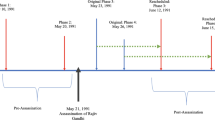Abstract
This paper examines an electoral competition model where a candidate allocates his campaign efforts (resources) on two competing projects prior to election. A candidate is congruent if his objective is consistent with the wishes of his constituents and there is no potential political shirking. We show that a congruent candidate needs not exert any efforts towards successful implementation prior to election; however, a less than perfectly congruent candidate must exert efforts prior to election. In equilibrium, two campaign resource allocation strategies emerge; (1) concentrate resources on one project and (2) allocate resources evenly across both projects. We discuss potential inefficiencies that are resulted by these allocation strategies.
Similar content being viewed by others
References
Abbe, O., Goodliffe, J., Hermson, P., & Patterson, K. (2003). Agenda setting in congressional elections: The impact of issues and campaigns on voting behavior. Political Reserach Quarterly, 4, 419–430.
Alesina, A. (1988). Credibility and policy convergence in a two-party system with rational voters. American Economic Review, 78, 796–805.
Bartels, L. M. (1985). Resource allocation in a presidential campaign. Journal of Politics, 47, 928–936.
Bawn, K., & Thies, M. (2003). A comparative theory of electoral incentives: Representing the unorganized under pr, plurality and mixed-member electoral systems. Journal of Theoretical Politics, 15, 5–32.
Bender, B., & Lott, J. J. R. (1996). Legislator voting and shirking: A critical review of the literature. Public Choice, 87, 67–100.
Berger, M., Munger, M., & Potthoff, R. (2000). The downsian model predicts divergence. Journal of Theoretical Politics, 12, 228–240.
Besley, T., & Coate, S. (1997). An economic model of representative democracy. Quarterly Journal of Economics, 112, 85–114.
Brams, S., & Davis, M. (1974). The 3/2’s rule in presidential campaigning. American Political Science Review, 68, 113–134.
Calvert, R. (1985). Robustness of the multidimensional voting model: Candidate motivations, uncertainty, and convergence. American Journal of Political Science, 29, 69–95.
Chapman, R., & Palda, K. (1984). Assessing the influence of campaign expenditures on voting behavior with a comprehensive electoral market model. Marketing Science, 3, 207–226.
Coyte, P. C., & Landon, S. (1989). The impact of competition on advertising: the case of political campaign expenditure. Canadian Journal of Economics, 22, 795–818.
Downs, A. (1957). An economic theory of democracy. New York: Harper and Row.
Fenno, R. (1978). Home style: House members in their districts. Boston: Little, Brown and Co.
Ferejohn, J. (1986). Incumbent performance and electoral control. Public Choice, 50, 5–25.
Fiorina, M. (1974). Representatives, roll calls, and constituencies. Lexington: Heath.
Groseclose, T. (2001). A model of candidate location when one candidate has a valence advantage. American Journal of Political Science, 45, 862–886.
Hinich, M., & Munger, M. (1992). The spatial theory of ideology. Journal of Theoretical Politics, 4, 5–27.
Hotelling, H. (1929). Stability in competition. The Economic Journal, 39, 41–57.
Milgrom, P., & Roberts, J. (1986). Prices and advertising signals of product quality. Journal of Political Economy, 94, 796–821.
Osborne, M., & Slivinski, A. (1996). A model of political competition with citizen candidates. Quarterly Journal of Economics, 111, 65–96.
Palda, K., & Palda, K. (1985). Ceilings on campaign spending: hypothesis and partial test with canadian data. Public Choice, 45, 313–331.
Petrocik, J. R. (1996). Issue ownership in presidential elections, with a 1980 case study. American Journal of Political Science, 40, 825–850.
Potters, J., Sloof, R., & van Winden, F. (1997). Campaign expenditures, contributions and direct endorsements: The strategic use of information and money to influence voter behavior. European Journal of Political Economy, 13, 1–31.
Prat, A. (2002a). Campaign advertising and voter welfare. Review of Economic Studies, 69, 997–1017.
Prat, A. (2002b). Campaign spending with office-seeking politicians, rational voters, and multiple lobbies. Journal of Economic Theory, 103, 162–189.
Snyder, J. M. (1989). Election goals and the allocation of campaign resources. Econometrica, 57, 637–660.
Wittman, D. (1983). Candidate motivation: A synthesis of alternative theories. American Political Science Review, 77, 142–157.
Author information
Authors and Affiliations
Corresponding author
Rights and permissions
About this article
Cite this article
Yi, D.T. Election campaign resource allocation. Public Choice 133, 91–105 (2007). https://doi.org/10.1007/s11127-007-9179-4
Received:
Accepted:
Published:
Issue Date:
DOI: https://doi.org/10.1007/s11127-007-9179-4




